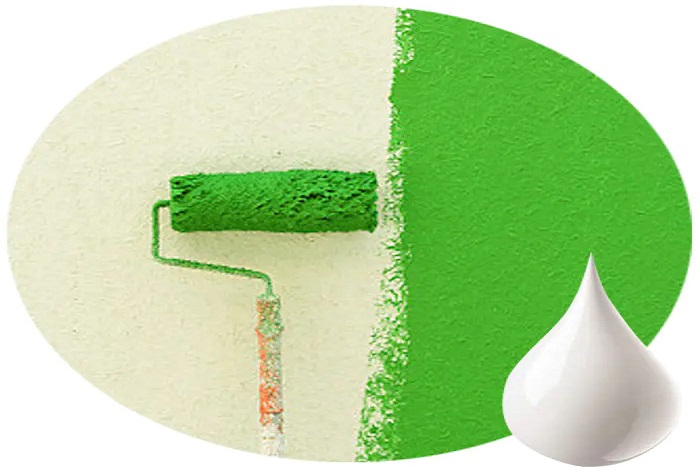Update:The most important thing in the water-based modified polyurethane coating is that the water-based polyurethane modified ...
The most important thing in the water-based modified polyurethane coating is that the water-based polyurethane modified acrylate resin combines the toughness and elasticity of the polyurethane resin with the good color retention, light stability, hardness and low cost of the acrylate. The main progress of water-based modified polyurethane materials is the development of chemical modification from the original physical mixing modification (called "in-situ polymerization"), that is, acrylate is first used as a solvent for synthesizing polyurethane, and then used as a solvent after dispersing into water. Reactive monomer polymerization. This can better improve the performance of the modified material. At present, the copolymerization modification of polyurethane and polyacrylic acid is also a commonly used modification method. In addition, the types of modified materials include modified epoxy resins, modified polyethers, and modified alkyd resins with polyurethane. Epoxy resin is a kind of thermosetting polymer composite material with good adhesion, corrosion, insulation and modified strength.
Modification method:
Waterborne polyurethane has some disadvantages, such as poor water resistance of the coating film, low hardness, low mechanical strength, etc., and needs to be modified. The main methods of modification are:
1) Silicone modification
The molecular structure of organosilicon compounds contains elemental silicon, which is a polymer compound of organic and semi-inorganic structure, and they have the characteristics of both organic compounds and inorganic compounds. Polyurethane is modified with silicone to make up for the slightly poor hydrolysis resistance of waterborne polyurethane, so that the modified waterborne polyurethane coating exhibits good hydrophobicity, surface enrichment, low temperature flexibility and excellent biocompatibility. Silicone-modified polyurethane can be carried out by physical blending, for example, physical blending modification with aqueous polyurethane and polysiloxane emulsion. Therefore, the most commonly used method for silicone modification of polyurethane is copolymerization modification. Through the stepwise addition of polysiloxane oligomers with reactive functional groups at both ends (the most common is polydimethylsiloxane PDMS, or polysiloxane obtained by partially substituted methyl groups) and polyisocyanates , polymerized to obtain block copolymers.
2) Epoxy resin modification
Epoxy resin is a polyhydroxy compound. In the reaction with polyurethane, branch points can be introduced into the main chain of polyurethane, so that it forms a partial network structure and has better performance. Through the grafting reaction of epoxy resin and polyurethane, epoxy-modified polyurethane emulsion is prepared, and waterborne epoxy-modified polyurethane coating can be prepared by using it, which can improve chemical stability, corrosion resistance and paint film adhesion.
3) Acrylate modification
Compared with other synthetic polymer resins, acrylates have many outstanding advantages. Acrylic-polyurethane hybrid aqueous dispersions prepared from acrylic and polyurethane polymers in microscopic state can obtain complementary properties. The water-based polyurethane/acrylate composite emulsion can organically combine the high tensile strength and impact strength, excellent abrasion resistance of polyurethane with the good adhesion, weather resistance and low cost of acrylate resin to prepare a high solid content , low cost and water-based resin that meets the requirements of use.
4) Nanomaterial modification
Nanomaterials have special properties such as surface effects, small size effects, optical effects, quantum size effects, and macroscopic quantum size effects, which can enable materials to acquire new functions.
5) Vegetable oil modification
Vegetable oil is a renewable resource, and the preparation of water-based polyurethane coatings with vegetable oil can further reflect environmental awareness. , is an environment-friendly paint, can be used as water-based interior and exterior wall paint, as well as wood decorative paint and fabric printing and dyeing paint. Using air-drying vegetable oil as the basic raw material, after modifying it, it is implanted into the semi-capped PU molecular chain to obtain self-emulsifying one-component water-based PU. The product has good emulsion stability and mechanical properties of the paint film. excellent. The linoleic acid diethanolamine intermediate is produced by aminolysis of linseed oil and diethanolamine. The water-based PU coating synthesized from this intermediate is water-resistant, quick-drying, strong adhesion, non-toxic, non-flammable, and viscous and easy to control. It is an excellent Environmentally friendly water-based paint.
6) Organofluorine modification
Using mercaptoethanol as a chain transfer agent, through radical solution polymerization, a hydroxyl-terminated macromonomer of hydroxyl-terminated fluorine-containing acrylates is synthesized, and the hydroxyl-terminated fluorine-containing acrylate polymer is further attached to the polyurethane segment. A fluorine-containing aqueous polyurethane dispersion was synthesized, and the test results showed that the surface of the membrane of the synthesized fluorine-containing aqueous polyurethane dispersion was enriched with fluorine.
 Decorative acrylic paint emulsion
Decorative acrylic paint emulsion 
